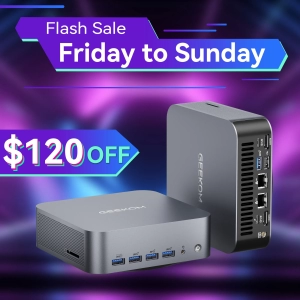Introduction
With the advent of technology, modern teaching is becoming increasingly effective. Technology facilitates pupils’ interaction with materials and peer collaboration through the use of digital resources and interactive lessons. However, the advent of high technology has led to an increased need for portable solutions that serve a dual purpose and that are reasonably priced and manageable on very little space. Traditional desktop personal computers are generally bulky and expensive unfit solutions for modern school systems seeking cost-effective methods for spaces that will optimize technology.
A mini PC is the perfect fit with efficient performance, a small size, and an affordable price, thus fitting within a constrained budget for schools and limited classroom space. With this series of mini PCs for education, flexible educational activities from classroom management to distance-learning sessions can take place. For IT administrators and educators, mini-PCs provide a functional, cost-effective approach to establishing tech-friendly classrooms without overwhelming spatial and budgeting considerations.
The Role of Mini PCs in Modern Classrooms
As education increasingly embraces digital learning, the demand for accessible and flexible technology has grown substantially. Teachers are expected to use digital tools in support of traditional methods of teaching but also to engage learning in a vibrant and interactive space within their classrooms. In cases where space and technical funds are limited, mini-PCs provide a solution. The PCs for education combine the various computing tasks needed into small boxes, leaving more space in the narrow confines of the classroom.
Educational Mini PCs offer adequate processing capability to support educational software, digital resources management, and interaction with interactive learning devices. Their compact size allows them to blend into various classroom layouts from student individual desks, shared workstations, or mobile carts moved from room to room. This adaptability enables educators to create a tech-friendly environment that can support diverse teaching methods, from traditional lessons to hands-on digital learning activities.
Mini PCs are practical educational management computers used for student learning. With their high efficiency and easy maintenance, these work well in classroom resource management, planning, and running daily school operations. A balanced representation of flexibility and reliability thus makes mini PCs a strong choice for schools looking for affordable classroom technology advancements. Thus, we convert mini-PCs into modern classrooms from a fitting educational lens by enabling flexible, powerful, and budget-conducive establishments to cover the growing needs of modern classrooms.
Why You Should Use Mini PCs in Education
Mini PCs have quickly become a popular choice in educational settings, offering numerous advantages tailored to classroom needs. Their compact design, affordability, and ease of use make them a valuable asset for schools aiming to create effective learning environments with limited resources.
Space Efficiency and Flexibility
Perhaps one of the great advantages of a classroom mini PC is its small size; thus, an educator can utilize the classroom’s space better. One of the main drawbacks of traditional PCs might be that they occupy more space, whereas mini PCs, having smaller dimensions, can be easily adapted to fit many styles of classroom configurations without cluttering desks. The nifty devices can be mounted behind flat-screen monitors, wall-mounted, or placed on carts to allow flexible classroom designs required for different teaching activities; this enables educators to use the space-aided classroom approach to develop interactive learning spaces without worrying about the issue of cramped spaces.
Cost-Effectiveness
Although budget is always a primary consideration for educational places, mini PCs are generally cheaper alternatives to traditional desktop computers available for making an education PC viable in schools with limited or no funding. Mini PCs allow for savings on energy costs aside from the reduced purchase price. Schools will be able to afford to acquire several input/output units without stretching their budgets and yet furnish each classroom with the technology that allows for modern learning practices. Because mini PCs are affordable, they stand a good chance of being adopted as an economical option to develop technology infrastructure by many schools.
Remote Learning Support
Mini PCs are extraordinarily functional inside a physical classroom and even further along with remote learning. These devices allow video conferencing, digital resource accessing, and hybrid ways of learning with out-of-the-box connectivity. Whether supporting one-to-many teachers or providing remote access for students, mini PCs are versatile in supporting distance learning. Schools can use mini PCs to keep students engaged and connected regardless of where they learn, which is so critical for today’s flexible and adaptable education systems.
Easy Maintenance and Management
If you or tech personnel in your school are responsible for technology throughout the entire school network, IT maintenance can be time-consuming. However, because a mini PC has fewer parts and a simple setup, it also greatly benefits IT administrators. A centralized web-based management console, secure web tools, and other features included in mini PCs make system updates, software upgrades, backup and recovery, security patches, application modifications, general maintenance, and system reboots simple across the network. This allows teachers and administrators to focus on student’s academic goals rather than tech issues that arise. The result is a more flexible learning environment that meets the needs of all types of learners in different settings.
In sum, mini PCs provide educational institutions with an efficient, budget-friendly, and easily manageable technology solution that enhances classroom flexibility and supports diverse learning setups.
Recommended Mini PCs for Educational Use
GEEKOM Mini IT12 – Basic Model for Classroom Use
The GEEKOM Mini IT12, the affordable mini PC for the classroom, fulfills basic educational requirements that require very little in the way of hardware resources. It offers adequate processing power for presentations, educational programs, and basic web browsing, powered by an i9-12900H or an i5-12450H in the 12th-generation Intel Core processor category. The variant featuring Intel Iris Xe Graphics (for i9) or Intel UHD Graphics (for i5) will handle multimedia content very well. This mini-PC supports a long list of ports, including two USB4 ports, to connect a range of peripherals like projectors and interactive whiteboards.
★★★★★ ( 5.0 Based on 90 reviews)
- 12th Gen Intel Core i9-12900H or i5-12450H.
- Intel Iris Xe Graphics for i9 or Intel UHD Graphics for i5.
- Comprehensive port selection, including two USB4 ports.
- 2.5G Ethernet, Bluetooth 5.2, and Wi-Fi 6E.
GEEKOM Mini IT12 is an ideal option for cost-conscious schools looking for a basic school computer to deliver daily classroom functions with no high-end features.
GEEKOM Mini IT13 – Mid-Range Model for Multi-Purpose Classrooms
The GEEKOM Mini IT13 steps up in processing power, making it ideal for multi-purpose classrooms where multitasking is essential. The Mini IT13 is equipped with a 13th Gen Intel® Core™ i9-13900H or i7-13620H with Intel® Iris® Xe graphics, thus providing excellent performance for light remote learning applications as well as some moderate computing power. It provides 8K output with quad display support, an immersive experience over several screens boon in multi-display classroom settings when screens are needed for split-screen teaching or student collaboration activities. The GEEKOM Mini IT13 has 2.5G Ethernet, Bluetooth 5.2, and Wi-Fi 6E, providing robust connectivity for reliable internet access and fast data sharing.
★★★★★ ( 4.9 Based on 79 reviews)
- 13th Gen Intel® Core™ i9-13900H, i7-13620H.
- Intel® Iris® Xe Graphics for i9-13900H & i7-13620H, Intel® UHD Graphics for i7-13620H.
- Comprehensive port selection, including two USB 4 ports.
- Supports up to 8K and quad displays.
- 2.5G Ethernet, Intel® Bluetooth® 5.2 and Wi-Fi 6E.
The GEEKOM Mini IT13 is thus reliable in its continuous performance mid-tier mini-PC for the classroom, allowing learning across hybrid cohorts by providing functions that rival performance.
GEEKOM A8 – Advanced Model for Remote and Hybrid Learning
The GEEKOM A8 features high-performance design elements, thereby making it suitable for schools adopting hybrid or fully remote learning models. It has enclosed AMD Ryzen™9 8945HS or Ryzen™7 8845HS, coupled with AMD Radeon™ Graphics 780M, providing power rendering for video conferencing virtual classrooms and heavy applications. It can run extensive multitasking and hefty work without a hitch, thanks to dual-channel DDR5 RAM with a viable capacity of up to 64GB and SSD storage expandable up to 2TB. It supports connectivity with 2.5G Ethernet, Wi-Fi 6E, and Bluetooth 5.2 – connectivity stability and speed is paramount to support teaching and learning remotely. The robustness of this model with undeterred graphics power guarantees that it will stand the test of time for schools ready to invest in future-proof digital learning solutions.
★★★★★ ( 4.9 Based on 42 reviews)
- AMD Ryzen™ 9 8945HS or Ryzen™ 7 8845HS.
- AMD Radeon™ Graphics 780M.
- Dual-channel DDR5 5600MT/s, up to 64GB.
- M.2 2280 PCIe 4.0 ×4 SSD, up to 2TB.
- 2.5G Ethernet, Wi-Fi 6E, and Bluetooth® 5.2.
Ultimately, the GEEKOM A8 is an ideal mini-PC for the classroom that meets the same performance standards for educational institutions as for hybrid or remote learning. Various applications within a school that require a dynamic connective system and speed are welcomed within the spectrum of advanced functionalities.
Practical Tips for Implementing Mini PCs in Educational Settings
Implementing mini PCs for education in classrooms can enhance the learning experience, but proper setup and maintenance are essential for optimal functionality. Here are some practical tips to help schools maximize the benefits of their mini PCs.
Setting Up in the Classroom
The positioning of mini PCs when set up for use must favour ease of access by students and teachers. Consider mounting mini PCs behind monitors or attaching them to mobile carts that can be wheeled around the room for flexibility. Position devices near power sources to avoid a buildup of wires, and attach USB hubs in the case of extra peripherals being required. This basic setup is in itself a space-saver and hygienic: mini PCs are handy for use in the classroom daily.
Software and Application Setup
Integration of educational software and tools, such as LMS like Google Classroom or Microsoft Teams for communication and assignments, or classroom management software like LanSchool or NetSupport for monitoring and guiding student activity, can help mini PCs perform better when used in schools. By installing antivirus and firewall applications, user data will be protected, and online surfing will be done safely. The installation of such software can assist instructors in creating a classroom technology environment in which instruction can flow easily, safely, and efficiently.
Maintaining and Updating Devices
Routine maintenance is essential in remaining functional and stable for computers dedicated to education. General housekeeping should include scheduling the periodic update of operating systems, drivers, and installed software. Regularly clean devices from dust accumulation that hinders performance. System health recorders allow the IT department to identify that the system is about to fail before it creates a management problem. Such maintenance guarantees mini PCs will serve educational objectives smoothly over time.
By arranging setup, installing the right applications, and following maintenance processes, schools create a solid and manageable environment where mini PCs encourage productivity and optimize the use of technology in classrooms for long-term success.
Conclusion
Mini PCs provide a compact yet powerful alternative for schools, merging performance into a small footprint. They can be easily accommodated in classrooms with space constraints, and due to their price, such systems are becoming more popular choices for schools wishing to grow their technology resources without straining their budgets. Mini PCs as school computers certainly satisfy functional requirements in both teaching and administration, supporting everything from basic classroom activities through remote and hybrid learning environments.
In addition, these classroom Mini PCs are designed with ease of management in mind to ease the setup and upkeep done by the IT staff. With a broad array of options to tailor your setup for different educational needs-from primary classrooms to advanced hybrid solutions, mini PCs are as flexible as modern education demands itself to be. It, thus, remains a realistic, scalable, cost-effective solution for schools and educational institutions wishing to enhance their technological infrastructures toward exciting, tech-centric learning environments.



























